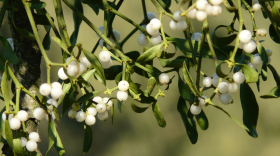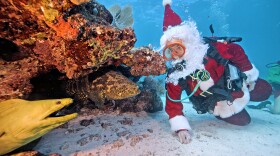It’s sea turtle nesting season and everyone knows what that means — turn off your lights at night.
Flipping your light switch is an easy way to feel like an environmental superstar, but what else can you do to support these little turtles?
One of the biggest challenges sea turtles young and old face is littering. The torn-off corners of chip bags that you don’t bother to chase down at the beach, tangled fishing line — even forgotten bottle caps — can make a huge difference in the lives of these sea creatures.
“The biggest threat to nesting turtles is the development of the beaches. When we develop the beaches, we change beach dynamics,” Conservancy of Southwest Florida Environmental Research Manager Dr. Jeff Schmid said.
Schmid has spent his life studying sea turtles and currently works with the Conservancy to track nests on Collier County's Keewaydin Island. His team of researchers traverses the island on ATVs, caging nests to protect them from predators, tagging and measuring mother turtles, and evaluating hatch success rates after sea turtles leave the nest.
They’ve seen firsthand how microplastics can interrupt the life cycle of sea turtles. A study published this month from the Marine Pollution Bulletin found that out of 209 beaches sampled, 45% had an abundance of microplastics. Normally hatchlings leave the nest in large groups, but microplastics alter humidity and fungal growth in nests causing small group hatching. Baby sea turtles leave the nest one by one, making them easy targets for predators.
“I was at the beach just the other night, and I noticed a lot of protected sea turtle nests. It made me smile at first but the longer I was there the more trash I would notice,” Georgia Omino said.
Omino visited Barefoot Beach, a nature preserve and nesting site for endangered loggerhead and green sea turtles.
Beach cleanups like those led by the Sanibel Captiva Conservation Foundation (SCCF) aim to reduce the presence of microplastics along the coastline. This past week, its Coastal Watch team partnered with Mind Your Line to combat injuries from discarded monofilaments and fishing lines.
“Anything can get caught in a fishing line. I myself find that when I’m collecting it out in the mangroves, I still get caught in the fishing line because those hooks are also left. As much as you’re trying to catch a fish in the water with your fishing line, it can have the same effect when it gets caught in a tree,” SCCF's Coastal Watch Technician Skye McDonald said.
SCCF’s volunteers comb the shore on foot, in boats, and even in kayaks to pick up everything from construction materials and appliances to cigarette butts and candy wrappers.
Volunteering with a beach cleanup crew is a great way to make a positive impact on sea turtles’ lives, but you can start at home, too. Choosing facial cleansers with natural exfoliants like sugar over plastic microbeads, using proper recycling practices, remembering to pick up all your trash before leaving the beach, and yes, skipping plastic straws, are easy choices you can make to keep the coasts safe for all kinds of creatures.
WGCU is your trusted source for news and information in Southwest Florida. We are a nonprofit public service, and your support is more critical than ever. Keep public media strong and donate now. Thank you.










